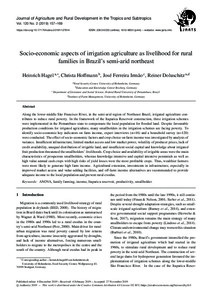| dc.date.accessioned | 2019-12-09T16:47:15Z | |
| dc.date.available | 2019-12-09T16:47:15Z | |
| dc.date.issued | 2019-12-04 | |
| dc.identifier | doi:10.17170/kobra-20191127814 | |
| dc.identifier.uri | http://hdl.handle.net/123456789/11378 | |
| dc.description | Gedruckte Ausg. im Verlag Kassel Univ. Press (www.upress.uni-kassel.de) erschienen. | ger |
| dc.language.iso | eng | eng |
| dc.rights | Urheberrechtlich geschützt | |
| dc.rights.uri | https://rightsstatements.org/page/InC/1.0/ | |
| dc.subject | ANOVA | eng |
| dc.subject | family farming | eng |
| dc.subject | income | eng |
| dc.subject | Itaparica reservoir | eng |
| dc.subject | productivity | eng |
| dc.subject | smallholder | eng |
| dc.subject.ddc | 630 | |
| dc.title | Socio-economic aspects of irrigation agriculture as livelihood for rural families in Brazil’s semi-arid northeast | eng |
| dc.type | Aufsatz | |
| dcterms.abstract | Along the lower-middle São Francisco River, in the semi-arid region of northeast Brazil, irrigated agriculture contributes to reduce rural poverty. In the framework of the Itaparica Reservoir construction, three irrigation schemes were implemented in the Pernambuco state to compensate the local population for flooded land. Despite favourable production conditions for irrigated agriculture, many smallholders in the irrigation schemes are facing poverty. To identify socio-economic key indicators on farm income, expert interviews (n=16) and a household survey (n=120) were conducted. The effect of socio-economic factors and crop choice on farm income was investigated by analysis of variance. Insufficient infrastructure, limited market access and low market power, volatility of producer prices, lack of credit availability, unequal distribution of irrigable land, and insufficient social capital and knowledge about irrigated fruit production threatened the smallholders’ livelihoods. Crop choice and availability of irrigable areas were the main characteristics of prosperous smallholders, whereas knowledge intensive and capital intensive perennials as well as high value annual cash crops with high risks of yield losses were the most profitable crops. Thus, wealthier farmers were more likely to generate high farm income. Agricultural extension, investments in infrastructure, especially in improved market access and value-adding facilities, and off-farm income alternatives are recommended to provide adequate income to the local population and prevent rural exodus. | eng |
| dcterms.accessRights | open access | |
| dcterms.creator | Hagel, Heinrich | |
| dcterms.creator | Hoffmann, Christa | |
| dcterms.creator | Irmão, José Ferreira | |
| dcterms.creator | Doluschitz, Reiner | |
| dc.type.version | publishedVersion | |
| dcterms.source.identifier | ISSN 2363-6033 | |
| dcterms.source.issue | No. 2 | |
| dcterms.source.journal | Journal of Agriculture and Rural Development in the Tropics and Subtropics (JARTS) | eng |
| dcterms.source.pageinfo | 157-169 | |
| dcterms.source.volume | Vol. 120 | |

